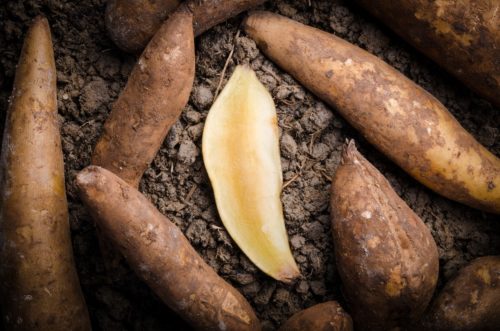
There are many advantages to growing your own yacon tubers. First, of course, you can enjoy eating the fresh tubers which are a delightful way to diversify your diet. They are a food that comes presweetened and have an amazing texture.
Most people fall in love with fresh yacon from the first juicy crispy bite they take! More people enjoy eating them raw as a standalone snack or as a side. Some people add a splash of lemon juice to keep them from oxidizing and turning brown.
Raw yacon tuber slices are also excellent mixed into vegetable salads or fruit salads. In fact, there is a fruit salad in South America that features sliced yacon tuber. It is called salpicon, which literally translates to “medley” or “hodgepodge,” but the star is always yacon because most South Americans won’t make it unless they have yacon on hand. Some people substitute sliced yacon for apples in classic Waldorf salad. This way you can enjoy the sweetness of yacon in its rawest form while adding sweetness to an entire dish!
Sliced fresh yacon tubers hold up as well as other sweet tubers like jicama when cooked on low to medium heat. They are delicious julienned in stir fries. You can also juice them and enjoy drinking the fresh juice or mix this juice with other nutritious foods to make smoothies as the fresh yacon juice will give you an automatic sweetener. Some people also like to add pieces of yacon (or grated yacon or juiced yacon) to soups and sauces to sweeten them. If you do this last minute, and keep the heat low, you will not lose much FOS (fructo-oligosaccharides) in the process.
Another big advantage to growing your own yacon in your garden is you’ll be able to harvest the large triangular leaves. In South America, they brew these leaves into a very tasty tea to enjoy and to combat diabetes, high cholesterol, and other diseases. In fact, the leaves of the yacon plant actually have a higher concentration of polyphenols than do the tubers and yacon syrup derived from the tubers. Besides the fructo-oligosaccharides, these polyphenols (various types of antioxidants) are what confer medicinal qualities to the yacon plant.
In South America, the leaves are often stuffed with vegetables and rice. The leaves serve as a steaming vessel. This is essentially the same cooking method as how dolmas prepared with grape leaves, cabbage rolls are prepared with cabbage leaves, and “banana boats” are made from banana leaves.
You can also substitute yacon leaves for aluminum foil when wrapping items for the grill. The leaves are perfectly edible and healthy so you can enjoy these grilled items wrapper and all! Further, this would make for a unique backyard party in the fall. You can harvest the leaves any time after the plant flowers.
Another major advantage to growing your own yacon is how well it enhances your soil. The fructo-oligosaccharides that feed the beneficial bacteria and yeast in your gut, and make them flourish and outcompete the bad microbes, will work the same magic on your soil microbes!
The healthiest most fertile soil is full of active soil microbes. They help release nutrients from organic matter, making them available to your plants and to you when you eat these plants. They fix nitrogen. They increase the uptake of phosphorous by your plants. They degrade toxins like pesticides and chemicals that have leached into your soil. They make it less likely for plant pathogens to take hold. They also improve soil structure by binding together soil particles. You just might notice a big difference in the yield and quality of your garden if you plant other vegetables in the same spot you planted yacon the year before or even in between yacon plants the same year!
While the diversity of yacon varieties is less than potatoes, there are at least twenty varieties you can find to buy if you search the internet. New varieties are also being developed but intellectual rights have stymied the sharing of these. In fact, when Japanese horticulturists developed new hybrids of yacon with crowns they got from Peruvian farmers, they wouldn’t even share the new hybrids with those same farmers!
At any rate, keep in mind that yacon tubers (and stems) come in a rainbow of colors. There are yacon with red, orange, yellow, white, and purple skins! The flesh can be creme, yellow, pink, or even white with purple rings! Each variety has its own unique flavor, texture, polyphenol composition (antioxidants), and FOS content…. so, have fun experimenting with different varieties, both the fresh tubers and the yacon syrup you get from them!
What to Do If You Can’t Grow Yacon
If you’re on a limited budget, and you don’t have time or garden space to grow your own yacon to make your own syrup, you may think healthy fructo-oligosaccharides are impossible for you. However, you can still reap the health benefits of yacon syrup by eating widely available vegetables that are high in fructo-oligosaccharides.
After yacon, the vegetables highest in fructo-oligosaccharides are jicama and sunchokes (Jerusalem artichokes). If you shop around, you can sometimes get jicama dirt cheap. Just like yacon tubers, jicama is delicious eaten raw, especially when cut into thin slices. Some people call these jicama chips. Some people love these with sprinkled with hot spices like chili powder. You can also get a good amount of fructo-oligosaccharides from eating asparagus, onions, garlic, and leeks.

Leave a Reply
You must be logged in to post a comment.